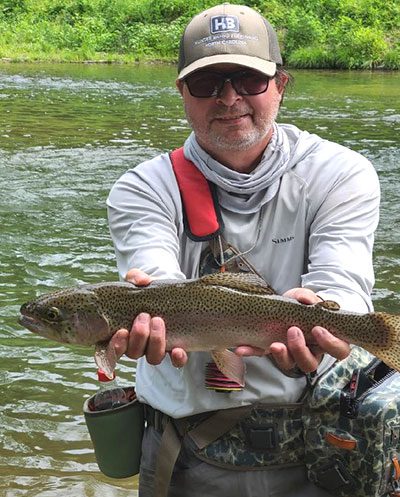As many of us have observed right now, our streams are low and our water temperatures have risen even in the higher elevations. These are not the ideal conditions to chase trout but it can be done and now more than ever the angler needs to have the fish in mind.
Trout right now are slow. Their movement is sporadic and they are trying to conserve as much energy as possible to survive. Wild trout especially need oxygen to survive; four parts per million or (PPM) in the stream or creek is the minimum. Cold water holds more oxygen so in warmer weather oxygen content is lower causing trout to become more lethargic and less active, making fishing more challenging and sometimes just not smart.
Trout feed best when water temp is between 45 and 60 degrees. Anything over 68 degrees is dangerous and can cause mortality. Trout being caught and handled properly has a survival rate of 70 to 80%, but when the fish is out of the water for around 30 seconds that drops to 60% and one minute out it goes down to 28%.
This being said, keep trout in the water, especially wild fish. Best scenario; take a look, use barbless hooks and make it a quick release. That satisfies most fly anglers.
Fly selection right now in low water conditions should not be over thought. A small yellow or olive caddis dry fly, with a #20 or #22 pheasant tail, with or without a bead will bring fish to the net. Just have confidence in the pattern and you will have action.
Most wild fish move upstream while stocked fish, in my experience, tend to move downstream. That being said, for both wild and stocked fish, make your presentation up and across and as always try to get that good drift. I always tell my clients, this fishing is 80% presentation, 10% fly and 10% angler.
In clear water, a variety of flies can bring you success; reds and oranges are good choices. Dark colors like black, blue and violet can be better. Flashy colors like yellow and orange can work well in bright conditions while white is a good color in stained or stirred conditions.
Longer leaders are a must right now and fine tipped preferably 6X or 6.5X trout hunter fluorocarbon works best. Always take time to look around and position yourself in a spot that doesn’t require a 50-foot cast and always cast softly and accurately as you can and make your first or second cast your very best if possible.
Low water means spooky fish, real spooky fish. Trout can move 25 body lengths per second so they are fast and they detect movement and predators from a great distance by their lateral line that runs down their mid-body. They can also detect danger and food even in dingy water and can use this lateral line to communicate with other fish as well as differentiate between color and objects.
We have many miles of wild trout water in Western, North Carolina and with the renovations of the trout hatcheries on the horizon, fly fishermen may have to modify their tactics. The trout there it’s going to take patience and more strategy and maybe more understanding of our true trout.
Technical fishing will make you a better fisherman so don’t get frustrated with low numbers and smaller fish. Fooling trout and imitating his food source to get him to the fly is what this sport is all about.
Wild fish are super gamey and usually you get one opportunity at them. As a guide, and getting feedback from clients, they really enjoy the challenge so landing one is usually pretty special.
The next few years are going to be a change in our flyfishing in Western, North Carolina. We have the fish, no doubt, but it’s going to take some skill, some research, and some conservation on our part to make it successful. GOOD FISHING!
